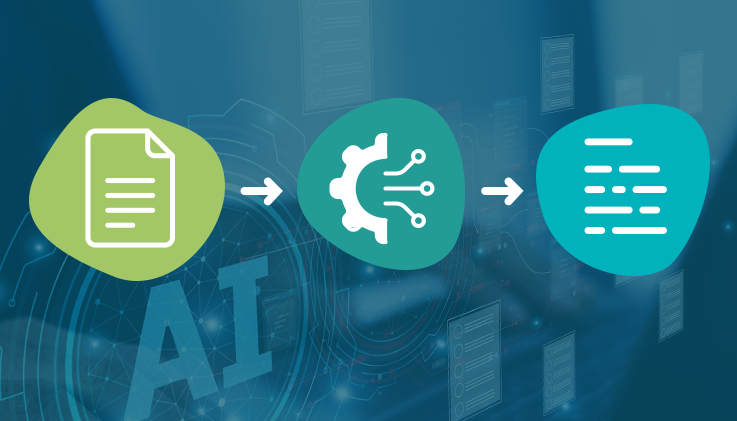Intelligent Document Processing And Recognition: The Smart Way To Work

Customers often send documents that hold critical information such as invoices, IDs, contracts, claim forms, payment proofs, or application letters that require careful handling. Traditionally, these documents were processed manually, which was slow and error prone. With intelligent document processing (IDP) and intelligent document recognition (IDR) techniques, this workflow can be automated to ensure easy and precise document recognition and information extraction.
Traditional document processing methods included multiple steps where agents first used to download the document, understand its content and manually extract key information, and then store it in an internal system or CRM software. Today’s AI-powered software offers IDP and IDR models that automatically identify and extract key information from customer documents they share. No doubt, this AI-driven processes ensure increased efficiency, reduced manual efforts, accurate data extraction, and many more.
In this blog, we will walk you through what IDP and IDR are, how it works, its benefits, use cases, and focus on other important insights. Stay tuned!
What is AI-driven document processing and document recognition?
Intelligent document processing (IDP) means automation of the entire document handling process, starting from the transformation of raw, unstructured data to converting it into actionable insights. It handles both structured and unstructured content, learning continuously to improve accuracy and efficiency. This feature acts as a powerful AI wingman for support agents by handling the complex task of data entry and document analysis so that agents can focus on more important customer support functions.
Intelligent Document Recognition (IDR) is far more than just scanning or OCR. It uses advanced AI to understand, extract, and categorize information from documents of any type, whether invoices, contracts, forms, or customer communications. Unlike traditional methods, IDR can interpret context, handle unstructured data, and even learn from corrections over time. This means businesses not only save hours of manual effort but also gain accurate insights that strengthen compliance, accelerate decision-making, and improve customer service.
IDP and IDR leverage a range of technologies for document processing and document recognition. IDP models visually interpret information of a document to understand the structure and fields within it. AI recognizes patterns in different documents to understand which information is important for extraction. Optical character recognition (OCR) is the data extraction component here that converts paper-based documents, receipts, invoices, contracts, legal documents, and more into digitized documents. Once the text is extracted by OCR, natural language processing (NLP) steps in to understand the context and meaning behind the words and numbers in documents.
All these technologies combine to create a structured pipeline to ensure each document goes through consistent stages of accuracy and compliance.
Also read: AI Agent – The New Face Of Customer Support And Omnichannel Communication
Use cases across industries
Let us take a look at how intelligent document processing and intelligent document recognition have a wide range of applications across various industries.
- Banking & financial services: Banking and financial services can automate a wide range of processes, from invoice processing and loan applications to insurance claims and financial statements. By extracting data from documents and digitizing paper records, institutions can accelerate customer onboarding, streamline KYC compliance, and make loan approvals faster and more convenient.
- Insurance: IDP and IDR revolutionize how insurance claims are handled and processed without any human intervention. It automates document validation that powers hands-free claims processing and detects anomalies for fraud prevention by extracting critical data from claims documents.
- Customer service: Support agents are able to focus on complex queries as IDP and IDR automatically extract important information from documents shared by customers while seeking support. This allows support teams to deliver fast and accurate responses while resolving basic queries.
- Healthcare: With AI-powered document processing, hospitals and healthcare institutions can digitize patient records, extract data from lab results and handwritten medical prescriptions, and capture medical details from unstructured sources.
- Human resources: The HR department can automate resume screening, job applications (resumes, certificates, academic records), employee contracts, timesheets, and performance reviews. Organizations can eliminate the manual effort of handling documentation and accelerate employee onboarding processes.
Harnessing the power of IDP and IDR for customer success
AI-powered document processing and AI-powered document recognition have enabled businesses to take a big leap forward that usher in a new era of achieving data accuracy and service efficiency. The following are some of the key business benefits that businesses gain.
- Increased efficiency: By streamlining document-centric processes, IDP and IDR enable end-to-end automation of fragmented and manual tasks. This creates a seamless workflow and allows businesses to process information faster.
- Accurate data extraction: Using OCR and NLP, IDP tools accurately identify relevant data from documents such as text, numeric values, images, and even signatures. This eliminates errors in data processing, leading to accurate outcomes.
- Document summarization: Intelligent document processing offers a unique document summarization feature where it reads and comprehends a lengthy document’s content and provides a concise summary. The summary includes key insights of the document that allow users to quickly grasp the core of a document.
- High savings: By automating repetitive tasks, businesses can eliminate costs arising from manual data entry and processing.
- Customer satisfaction: Support agents can leverage AI to process customer documents more efficiently. By creating workflows where human or AI agents use extracted data to address queries, businesses can deliver faster responses and significantly improve customer satisfaction.
- Eliminating language barriers: Intelligent document processing and document recognition tools generally offer high-accuracy multilingual document translations. This enables effortless communication between globally distributed teams that have diverse linguistic backgrounds.
Also read: Top Reasons Your Support Center Needs Smart Tools For Managing Service Operations
Ensuring data security
Document processing and document recognition tools are designed with data security and data privacy measures to protect sensitive data and adhere to data privacy regulations such as GDPR and CCPA. The tool maintains logs on actions taken on a document by maintaining an audit trail. Businesses can comply with data subject rights under data privacy regulations by handling customer requests for data access, correction, or deletion, and ensuring they respond to these requests within the legal time frame.
If we take a look at the banking industry, then customers share their financial statements and transaction records while applying for a loan. In insurance, customers share photos of property damage or a personal identification document like a driver’s license. Whereas in the healthcare industry, submitting medical bills or lab reports is common practice. All these documents include personal and confidential information, which is processed safely through IDP and IDR tools to maintain customer trust and ensure organizations comply with data regulations.
Document processing and document recognition by ThinkOwl
Automatic document recognition starts with Optical Character Recognition (OCR), which reads and interprets text from scans. Integrated with AI, the system not only locates content but understands it in context, ensuring highly accurate data that can immediately trigger workflows.
ThinkOwl's Intelligent Document Recognition combines advanced AI with content classification, data extraction, and transaction export. From capturing text with OCR to transferring data into business systems, it delivers end-to-end process automation across all platforms. As modern support teams depend on fast data insights, an IDP tool empowers them to quickly turn unstructured data into something actionable.
Intelligent document recognition on OwlForce is built with advanced AI for comprehensive process automation that significantly reduces manual errors, accelerates response times, and improves overall efficiency. It handles documents with diverse content structures, ranging from handwritten text to fields and tables, to provide maximum business efficiency. Explore smart solutions by ThinkOwl, and sign up for a free demo.











